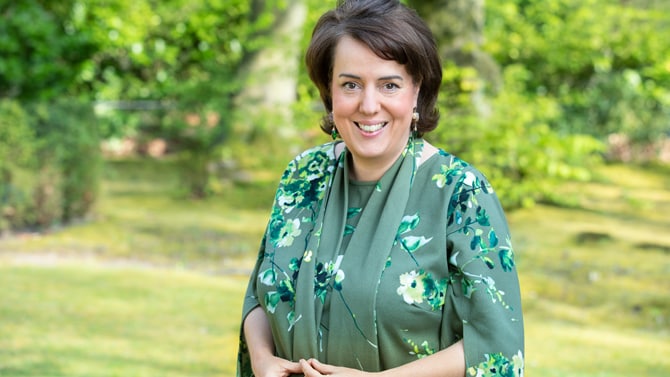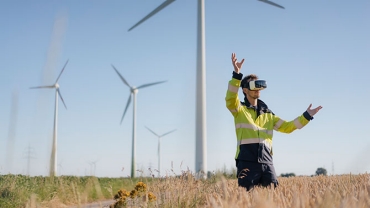
Mind the funding gap
To achieve the ambition set by the European Green Deal, significant investments are needed that require mobilising both the public and private sectors. To this effect the European Commission (EC) has outlined plans to mobilise 1 trillion EUR in sustainable investments over the next decade. Leveraging both public and private capital, this amount will be mobilised by greening the EU budget and also through private-public partnerships, according to the scheme pictured in Figure 1.
About half of this funding (about 500 billion EUR) will come from the EU budget, while 114 billion EUR will come from the Member States in the form of either public or private co-financing of projects.1 The rest of the 1 trillion EUR mobilised by the EU will need to come from private sources, some of which will be backed by guarantees by the European Investment Bank (EIB).
Nonetheless, the 1 trillion EUR does not represent the full cost of the transition that will be needed in the years ahead. The European Commission estimates that achieving the current 2030 climate and energy targets will require 260 billion EUR in additional investments annually, i.e. 2.6 trillion EUR over 10 years.
With these figures in mind, it is clear that a significant part of the investments needed to make a green transition over the next ten years would need to come from the private sector. Is there a business case for private parties to invest in projects that support the Green Deal?
1 National co-financing is the share of project expenditure that is not covered by the EU budget, and has to be guaranteed through national contributions from either public or private national sources.

Making green investments happen
- What drives investments?
- The promise of profitability
- What hurdles remain?
- Can the Green Deal help?
What drives investments?
Over the past years we have seen a ‘greening trend’ among investors and corporates alike. Financing is therefore to some extent already driven by private rather than public money. Three drivers lie behind this trend: stakeholder pressure, government policy and profitability of green investments.
- Stakeholder pressure
Consumers are top influencers and are seeking out more sustainable brands, with green considerations playing a stronger role in decision-making. According to PwC’s 2020 Global Consumer Insights Survey, 43 percent of global consumers expect businesses to be accountable for their environmental impact.
For business to business relations, the pressure to ensure environmentally and socially responsible practices is generated through increasingly integrated supply chains. Companies pass their expectations and ambitions for sustainability on to their suppliers, who pass it to their suppliers and so on. This process is making sustainability an increasingly important focus of business-to-business interactions.
Equally for the financial sector sustainability is becoming top of mind in a way it has not been before. The past years have seen an increase in sustainable projects and transactions to finance those projects. When the UN backed Principles for Responsible Investment (PRI) were launched in 2006, 63 investors with $6.5 trillion in assets under management signed a commitment to incorporate environmental social and governance (ESG) issues into their investment decisions. By April 2018, the number of signatories had grown to 1,715 and represented $81.7 trillion in assets under management.2 In addition, sustainable assets globally, defined according to ESG criteria, have increased by 34% since 2016.3
Last but not least, employees are using their power to leverage change within their companies, and companies need to show that they are sustainable in order to attract new talent. - Anticipation of (future) regulation
Some companies anticipate future government policy and regulation that will further encourage the green trend and put old technologies and business models at a disadvantage. We are already seeing examples of this such as the Dutch Climate Agreement and the new EU Taxonomy on sustainable finance - an EU classification system for sustainable activities to help the financial sector and companies determine which activities qualify as sustainable in order to meet the EU’s goals on mitigation of and adaptation to climate change.4 In line with the anticipation of new ‘green’ regulation, companies are also divesting ‘brown’ assets for fear of future financial losses. - Increasing profitability of green investments
Some companies are already able to combine profitability and environmental sustainability. The renewable energy sector is one example. This is explored under the next tab, the promise of profitability.
2 Harvard Business Review (2019), The Investor Revolution.
3 OECD Observer, Sustainable investment: A new landscape, November 2019.
4 EU taxonomy for sustainable activities
The promise of profitability
Some companies are already able to combine profitability and environmental sustainability. The renewable energy sector is one example where this is happening successfully, as the global expansion of renewable energy shows. Renewables accounted for at least 70% of total capacity expansion in almost all regions in 2019.5 Wind and solar accounted for 90% of all the added capacity in renewables in 2019.6 This is against a background where global investments in renewables have grown steadily for more than a decade.7 In terms of market activity, the multitude of transactions in this segment indicate investor appetite to finance those projects.
One way of looking at these trends is to use a Marginal Abatement Cost (MAC) curve as a tool for presenting the costs of various technologies that can help reduce carbon emissions. The abatement cost is the cost of reducing emissions, and the marginal abatement cost is the relative cost of reducing one more unit of emissions (usually tonnes of CO2). Marginal abatement costs can be negative if a low carbon option is cheaper than the business-as-usual option, but costs rise steeply as more CO2 is reduced.
If we look at a stylised marginal abatement cost curve for CO2 emissions (see Figure 2), we are now at a point where some types of investments in the energy transition are becoming profitable. Projects such as wind and solar have a negative marginal abatement cost (they are below the zero line), meaning that they represent profitable options to reduce CO2 emissions. For example, solar PV and offshore wind projects have shown declining costs over the past decade (see Figure 3). Globally, the cost of energy has dropped by 82% for solar PV, 39% for onshore wind and 29% for offshore wind since 2010.8 Because of this, offshore wind farms in the Netherlands, which started out being heavily reliant on government subsidies, will in the future be able to operate without subsidies.9
Once we have collected the low hanging fruits to the left on our graph, the costs of the energy transition will increase because marginal abatement costs rise steeply as more CO2 is reduced. At the right end of the graph are the large scale projects, such as switching from natural gas to green or blue hydrogen, or implementing large-scale carbon capture and storage (CCS) projects. These are new technologies in development that are still very expensive.


However, five trends are helping reduce costs as technologies move from above to below the zero line on the MAC curve:
- Technologies mature
Many clean energy technologies are not sufficiently mature to be cost-competitive for deployment on a commercial scale. As technologies mature and become more efficient, they also become cost-competitive and therefore commercially viable. - Learning costs decrease
Learning costs decrease as we are moving up the learning curve. People learn how to implement, budget and generally work with new technologies which lowers costs and make these new technologies more profitable. - Economies of scale
As technologies mature, projects can be scaled up. Economies of scale enable efficiencies in production that put downward pressure on prices. - Collaboration lowers coordination costs
Large-scale energy transition projects often need more capital and have higher operational expenses. These projects will need large-scale infrastructure investments that cannot be handled by one actor alone. Cooperation between parties will lower coordination costs, and can unlock value creation for all parties involved. With increasingly complex projects, financing will also get more complex and risks are harder to assess. Collaboration also helps to spread risk in a way that would make projects more appealing to investors. - De-risking will lower financing costs
Many banks and financial institutions want to profile themselves as sustainable investors, However, they often lack a clear track record on green investments, which makes it hard for them to assess risks. For banks, the lack of precedent has meant that many sustainable projects do not fit their traditional risk models and are therefore deemed too high risk with potentially too low returns. Many sustainable projects will pay back in the mid to long-term, which is a longer time horizon than what is typically the case for non-sustainable ‘business-as-usual’ investment. De-risking these projects by providing government or EIB guarantees to back projects would work to lower financial costs.
5 Except in Africa and the Middle East.
6 IRENA (2020), Renewable Capacity Statistics 2020.
7 EEA (2019), Renewable energy in Europe - 2019..
8 IRENA (2020), Renewable Power Generation Costs in 2019.
9 PwC (2018), Unlocking Europe’s Offshore Wind Potential.
What hurdles remain?
- Technology risks
There are still a lot of unknowns around nascent technologies that can help mitigate climate change. Who will carry the risk for the highly innovative but risky projects that will be needed to make the transition to a sustainable economy? Whether financing on the capital markets is available or not will depend on the maturity of the technology. Without the adequate financial incentives - subsidies, taxes and/or guarantees - high risk sustainable projects will not be able to attract finance, as there is no track record yet on the performance of these types of projects. - Regulatory risk
In addition to technology risks, many projects needed to make the green transition also face regulatory and policy risks. This uncertainty also means less appetite for investment. With the amount of innovation needed to make the green transition, reducing regulatory risk and giving a sense of policy direction is key. For example, the Dutch-German electricity transmission system operator (TSO), TenneT, indicates that in order to change the Dutch infrastructure to support the transportation of hydrogen in 30 years from now, they need to invest now. For those investments to happen, the company needs clarity on the policy and regulatory landscape going forward.
Can the Green Deal help?
- Providing a common sense of direction
To accelerate the green transition further, a clear investment plan that supports the transition is needed at the EU level as well as at national levels. The Green Deal provides the first elements of such a framework. Additionally, a clear and stable regulatory regime is essential for companies to know which investments to make. - Common definition of sustainability
Similarly, having a common and clear definition of what counts as a sustainable investment helps. This is why EU regulations and the new EU Taxonomy on sustainable finance are welcome steps to create a shared definition of what counts as sustainable. Because the regulation is EU wide, it will create a level playing field in the financial sector across Europe, where there are still big regional differences in what types of projects banks can or will support. - Subsidies and (tax) incentives are still needed
The magnitude of investments needed mean that there will be strong need for government support in the years to come. When technology and regulatory risks are substantial, there is a bigger need for public support. This will include (tax) incentives and subsidies, as well as government investments in, for example, energy infrastructure. We will dive into this topic further in our subsequent editions of the Green Deal Monitor.
Key takeaways for organisations
- Private stakeholders and government policy will encourage sustainability going forward.
- The green transition is an unstoppable train and being an early mover can bring advantages down the line.
- Companies can expect new EU and government regulations to come into play in the coming years as the government takes an increasingly active role in facilitating the green transition.
- As technologies mature and we learn more about them, economies of scale and collaboration will lower costs and make projects more profitable.
- The financial sector can facilitate a transition as it redirects capital flows towards sustainable projects.


Balancing our way towards an ever-greener economy
Manon van Beek (CEO) and Otto Jager (CFO) on TenneT, corona, and the energy transition
"In the coming years, that investment agenda will increase to four to five billion euros a year, with some ninety percent being directly related to sustainability."




















